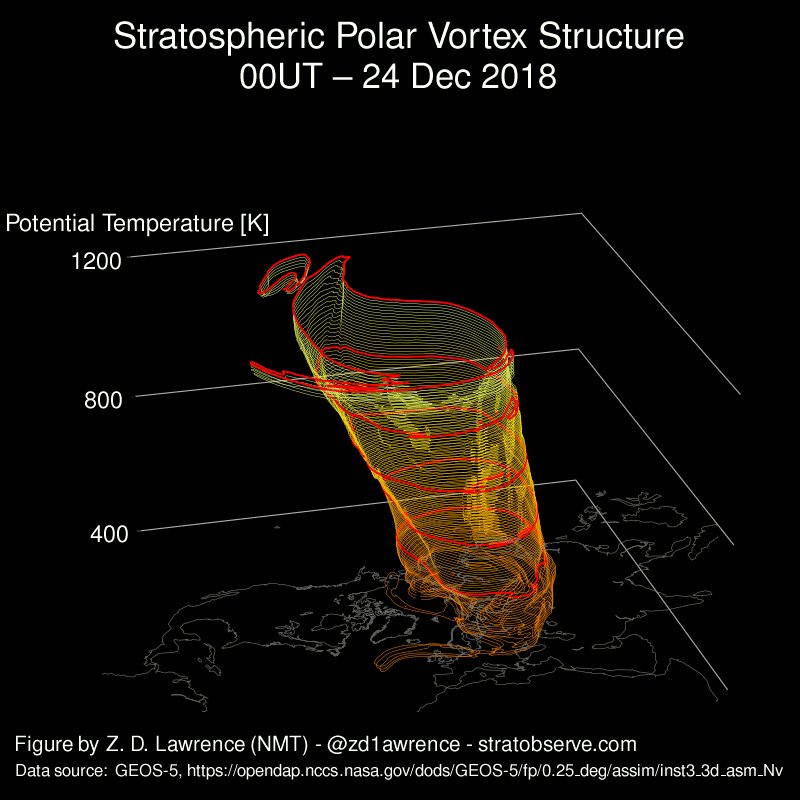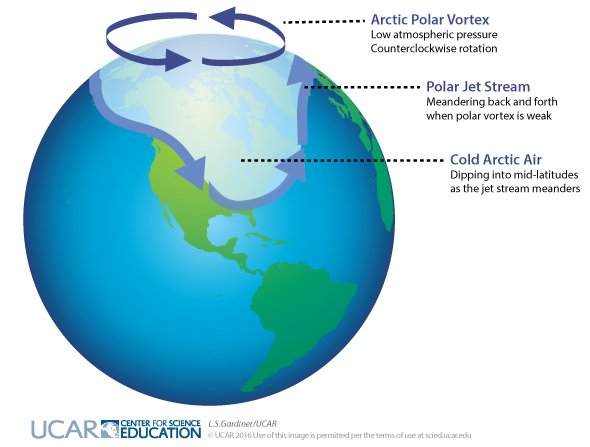Mashable – Science
The polar vortex will return, this time with the coldest temps of the year
By Mark Kaufman January 24, 2019
 Temperature forecast for early February 2019. IMAGE: UNIVERSITY OF MAINE/CLIMATE REANALYZER.
Temperature forecast for early February 2019. IMAGE: UNIVERSITY OF MAINE/CLIMATE REANALYZER.
It’s coming back!
“It’s going to get really cold at the end of January and early February,” Jeff Weber, a meteorologist with the University Corporation for Atmospheric Research, an earth sciences research organization, said in an interview.
Although the arrival of chilled air is still around a week away, meteorologists widely agree that it’s safe to expect extreme cold. Cleveland will likely drop to around zero degrees Fahrenheit, New York City to the teens, and some areas like Duluth, Minnesota will plummet to negative 25 degrees, said Weber.
Why is the polar vortex coming back?
If the polar vortex is left undisturbed, it will spend the winter at home, so to speak, rotating around the Arctic.
But this formidable mass of cold air can sometimes grow weak, wobbling out of its polar home. After this happens, these weakened polar winds can can slosh into the U.S. multiple times throughout the winter.
“Once the vortex is disturbed, the areas of colder air can spill out,” noted Weber. “We expect lobes to spill out over time.”
The polar vortex first began to get wobbly in early January, after showing signs that it might split apart. These polar winds are always liable to get pushed around by fickle weather patterns, storms, or other disturbances that move around our atmosphere, Benjamin Zaitchik, an atmospheric scientist at Johns Hopkins University, said in an interview.
And sometimes, the polar vortex will get completely thrown out of whack thanks to dramatic warming events that occur some 20 miles up in the atmosphere, called sudden stratospheric warming, which splits the polar apart. This “knocks the vortex out of its cozy home,” said Weber.
Zac Lawrence: Here is my “official” 3D animation of this year’s stratospheric #PolarVortex split. Another beautiful event!
It’s “like a band of warm air just cutting right through the puddle of cold air,” John Martin, an atmospheric scientist at the University of Wisconsin-Madison, explained last week.
This creates different vortices that are liable to wobble down to different regions, like the U.S. and Europe at the same time, which happened in mid-January.
“It starts to wobble and spill cold air out to the south,” said Weber.
What exactly triggers these warming events high up in the polar vortex remains unknown.
“It’s a hot area of research,” said Zaitchik. “It’s something that’s still being investigated.”
Replying to rahmstorf: A young and brilliant mathematician, Marlene Kretschmer, has spent the past years crunching decades of weather data. Using methods like cluster analysis and causal effect networks. She has just finished her PhD thesis in my department at the Potsdam Institute.
Stephen Rahmstorf: Kretschmer has found that over the last decades, the stratospheric polar vortex has become weaker and less stable, so Arctic air masses can escape more easily towards the North American and Eurasian continents. Here a schematic from UCAR.
The polar vortex has become a popular phenomenon for good reason: This weakening of the polar vortex and the subsequent spillover of frigid air has become more common over the last two decades.
“We are seeing these events occurring more frequently as of late,” noted Weber.
One emerging theory blames significantly diminished Arctic sea ice. The Arctic is warming over twice as fast as the rest of the globe and sea ice cover is plummeting. As a result, recent climate research suggests that — without this ice cover — more heat escapes from the oceans. Ultimately, researchers found that this relatively warmer air interacts with and weakens the winds over the Arctic, allowing frigid polar air to more easily escape to southerly places like Cleveland and New York City.
It’s important to note, however, that although the U.S. and Europe are experiencing more cold blasts from the Arctic, this doesn’t mean the planet isn’t still warming at an accelerated pace. Rather, these cold blasts are just displacing Arctic air that often stays put over the Arctic.
In 2019, it’s forecast to return during the last couple days of January.
“This will be our second blast of it,” said Weber.
Author: John Hanno
Born and raised in Chicago, Illinois. Bogan High School. Worked in Alaska after the earthquake. Joined U.S. Army at 17. Sergeant, B Battery, 3rd Battalion, 84th Artillery, 7th Army. Member of 12 different unions, including 4 different locals of the I.B.E.W. Worked for fortune 50, 100 and 200 companies as an industrial electrician, electrical/electronic technician. View all posts by John Hanno


